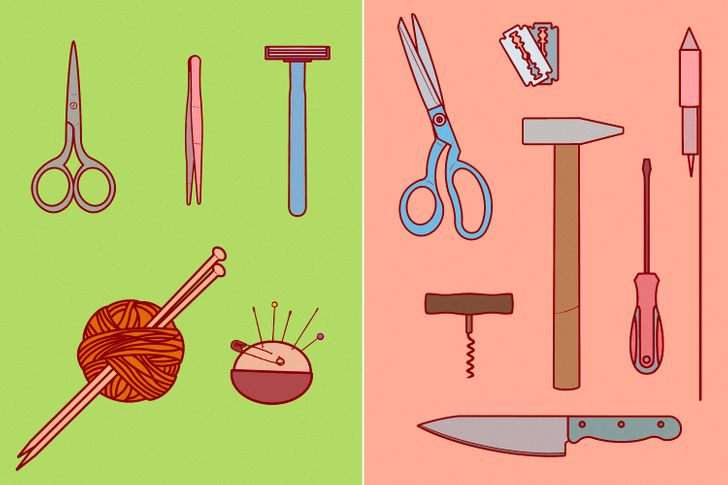
What You Can and Can’t Take in Your Carry-On Baggage
Anyone who has been on board a plane at least once has probably heard about the ban on taking drinks, chemicals, and sharp objects with them. But not everyone is aware of the other restrictions. What else can’t be taken on board? And what, on the contrary, is actually allowed?
5-Minute Crafts will help you pack your things for your trip correctly and take all the important details into account.
Liquids

- Liquids in containers of up to 100 ml each are allowed in carry-on baggage. Larger containers are not allowed. This also applies to those containers that are not completely filled.
- The total volume of liquids in carry-on baggage must not exceed one liter.
- All items containing liquids in carry-on baggage should be packed in a securely closed transparent plastic bag. Each passenger is allowed to take only one plastic bag of liquids in their carry-on baggage.
- Liquids include: any drinks, semi-liquid foods (syrups, soups, jam, honey), perfumes, toiletries (like toothpaste, shampoo, deodorant), beauty products (including creams, gels, mascara, and lip gloss), and contact lens fluid.

There are a number of exceptions for the transportation of liquids. You are allowed to take liquids in containers that exceed the volume of 100 ml, if:
- They are intended for medical or dietary purposes. If so, you have to present a doctor’s certificate stating why you need to take one or another medication, with a volume that exceeds the permissible limits, with you.
- It is baby food or milk needed to feed a baby.
- The liquid was purchased in the duty-free zone at the airport. However, in this case, your purchase must be sealed in a transparent bag along with your receipt before arriving at your destination.

Food

Foods are generally fine as long as they are not liquid. However, some foods are not allowed to be taken into and out of certain countries and it’s advisable to check with the country you are visiting if you intend to carry any other types of food.
Medicines and medical equipment

There are no strict requirements for the carriage of medicines in carry-on baggage if you follow the rule on the volume of liquids (no more than 100 ml). You can take pills or medicinal capsules, syrups, solutions, or potions (in containers up to 100 ml), inhalers, and even oversized medical equipment.
Electronics

You can safely take most electronic and electrical devices with you on board but they can make your carry-on baggage too heavy. Most airlines allow hair dryers, hair irons, travel irons, laptops, tablets, MP3 players, and electric shavers on board. But it’s important to know that all electrical devices must be in working condition at the time of the flight. The airport security can ask you to turn on the device and, if it doesn’t work, refuse to transport it.
Sharp objects and explosives

To avoid unpleasant situations during boarding, it’s better to put all sharp objects into your checked-in baggage.
- In carry-on baggage, you’re allowed to carry: nail scissors (with blades up to 2 inches long), tweezers, knitting needles, sewing needles, nail clippers and nail files, scissors with a rounded end, and razors with fixed cartridges (disposable razors).
- You’re not allowed to carry: scissors with blades longer than 2 inches, knives, cutlery, a corkscrew, razor blades, or fireworks. Chemicals like cleaning products and hair dyes containing hydrogen peroxide are not allowed in carry-on baggage. Work tools like screwdrivers, hammers, and saws are also not allowed.
Tourist and sports equipment

Most tourist and sports equipment is prohibited in carry-on baggage. Not only because of its size, but also because of the risk of injury. Fishing rods, oars, harpoons, trekking poles, diving equipment, skates, darts, tennis rackets, golf clubs, and martial arts equipment are prohibited for transportation in the aircraft cabin. You are allowed to take a parachute as carry-on baggage.
What else can you take along in your carry-on bag

The permitted size and weight of carry-on baggage can vary significantly from airline to airline. Therefore, it’s worth clarifying how many items you can take with you on board before the flight. But most carriers will allow you to take a small bag into the cabin (this can be, for example, a small backpack, a handbag, or a laptop bag), or an umbrella, a cane, crutches, and other equipment necessary for a person to move, and duty-free goods, in addition to hand baggage. Also, some airlines allow you to take a child car seat with you (especially, if the child is flying with their own ticket) and a folding stroller. However, it’s better to clarify the possibility of carrying these items as carry-on baggage before the flight.
Important: Please note that during a transit flight, some airlines may not allow you to take duty-free goods purchased at a previous airport in your carry-on baggage.